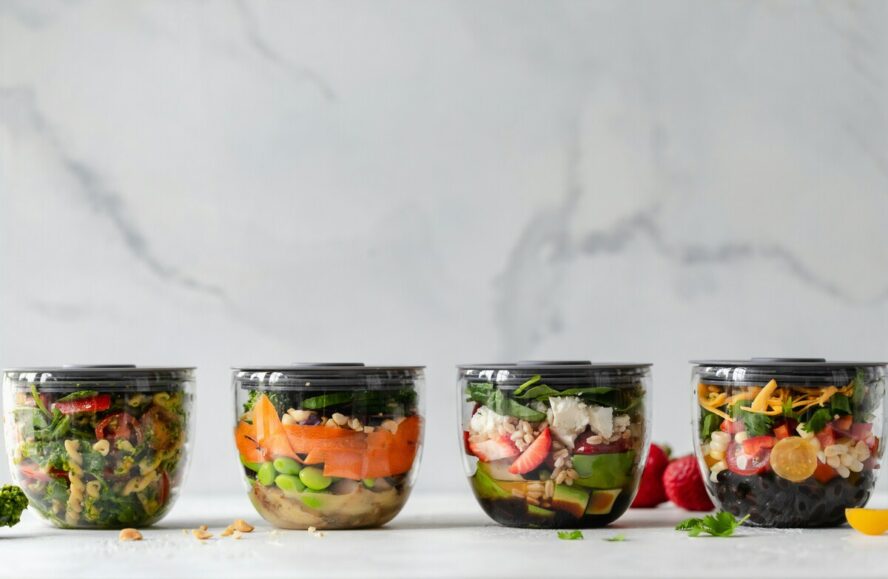California Bans UPFs in School Lunches — But What Are Ultra-Processed Foods, Exactly?
This is the end of chicken nuggets and hot dogs in school lunches in California.

In early October, California Governor Gavin Newsom signed the country’s first law to remove ultra-processed foods from school lunches. And since according to a recent CDC report, children in the United States get nearly two-thirds of their calories from ultra-processed foods, this move couldn’t come at a better time1.
Ultra-processed foods (UPFs) have been linked to a panoply of health risks, from high blood pressure2 to early death3. And in children specifically, researchers have observed an increase in behavioral problems and cognitive deficits that could impact them for the rest of their lives4. This evidence is part of what’s motivating a current crusade against UPFs. This crusade is led by Health Secretary Robert F. Kennedy Jr., who has dubbed these foods “poison” and vowed to take a serious stance against them in the upcoming revision of federal nutrition guidelines5.
But Kennedy and Newsom’s approaches to legislation around this category of foods feature some major differences. While the California law seeks not just to eradicate ultra-processed foods but also to better define them, Kennedy’s proposed revamp of the federal health guidelines is actually removing a lot of much-needed clarity and understanding of modern food science. And according to experts, both approaches need some editing if they’re really going to help reduce our reliance on ultra-processed foods.
California’s “Real Food, Healthy Kids Act” Provides Clarity, But Needs Nuance

The new “Real Food, Healthy Kids Act” signed by Newsom seeks to ban ultra-processed foods from an estimated 1 billion meals served in California school lunches for children. And to ban these foods, they first need to be defined.
The law offers a structured approach to categorizing a food as ultra-processed. So according to this law, what are ultra-processed foods? First, it must contain one of several non-natural substances in eight different categories, which include emulsifiers, stabilizers, and flavor enhancers. The food must also have high amounts of saturated fat, sodium, added sugar, or non-nutritive sweeteners. Minimally prepared foods, like canned fruits and vegetables, will not be considered ultra-processed in the eyes of the law, but most fast food, candy, and premade meals will.
The Risks of This Categorization
All of this sounds good in theory, to design healthy school lunches for the future generation. In practice, however, Destini Moody, RD, CSSD, LD at Live it Up says some foods might erroneously end up on the naughty list.
“Things like breakfast cereal and peanut butter and jelly sandwiches like Uncrustables are classified as UPFs, but are actually great for kids,” she says, noting that PB&J is a great way to get kids the fast energy and fats they need, and fortified breakfast cereals can help provide a palatable source of vitamins and minerals that, she says, “are typically contained in foods that children do not typically like to eat in large amounts, such as certain vegetables and whole grains.”

The other major hitch with this plan is the timeline. While early drafts of the bill proposed regulatory action to begin as early as next year, the final law gives food vendors and schools way more time to comply.
Food vendors must report all ultra-processed foods by February 2028, and the state’s public health department has until the middle of the year to adopt rules defining “ultra-processed foods of concern” and “restricted school foods.” These foods won’t be phased out until 2029, with their ultimate ban planned for July 2035. This slow roll allows loads of time for regulatory action, but it’s hardly great news for families with kids in school right now.
The New Federal Guidelines Promise Action but Deliver Mere Confusion
New federal health guidelines are meant to be published every five years. But while the latest version of this essential document was due this fall, Kennedy has already breezed through several self-imposed deadlines for its release6. We can, however, surmise that there will be some major changes to the guidelines — and the news doesn’t look promising.
Typically, federal health guidelines follow the recommendations of an advisory committee that spends about two years reviewing the latest nutrition science. But according to Kennedy, previous iterations have been so complex as to be “incomprehensible” for consumers. As a result, in April, he indicated that he’ll be disregarding the committee’s report, reducing the guidelines from their previous 164 pages to a mere four to six. This likely means a shift away from specific recommendations in favor of a more general focus on his promise to counsel a diet made up of “whole foods, healthy foods and local foods.”
But while we’re all in favor of the message, the severely shortened document is actually cause for major alarm, explains Grace Chamberlin, MPH.
How New Guidelines Could Affect Everyday Americans
“Guidelines shape not just population dietary advice, but also federal nutrition programs that serve one in four Americans,” she writes for Center for Science in the Public Interest7. Notably, the guidelines contain specific targets for calories and nutrients that guide programs like school lunches, federal food aids, and menus at military bases and federal prisons. A less complete document could cause “substantial chaos,” Kevin Klatt, a nutrition research scientist at the University of California, Berkeley, tells NPR8.
“Replacing that with a four-page, consumer-oriented document telling people to eat ‘whole foods’ and ‘unprocessed foods,’ none of which has a real definition?” he says. “There’s no way that that can hold any policy weight.”

Which brings us to the question of UPFs. While California’s legislation offers a more complete picture of this nuanced category, it seems that defining UPFs is a low priority for the federal guidelines. Despite Kennedy’s vociferous disapproval of ultra-processed foods, the Make America Healthy Again (MAHA) Commission’s September report on the category merely promised that the government would “continue efforts” to define ultra-processed foods. Ultimately, this ultra-processed foods definition is a promise the government has yet to make good on.
According to Barry Popkin, the W.R. Kenan, Jr. Distinguished Professor at the University of North Carolina at Chapel Hill’s Gillings School of Global Public Health, this is likely down to interference from agro-industrial lobbyists. “In my opinion, it shows the food, agricultural, and pharmaceutical industries got to the White House and won the day,” Popkin told CNN.
Guidelines Likely to Contradict Modern Nutrition Science
Despite their brevity, the new guidelines are also likely to include a few points of contention with regards to current nutrition science. Experts surmise that since Kennedy is a proud follower of the carnivore diet, it seems likely that meat and full-fat dairy will be spotlighted in the new guidelines, with the potential to raise or even remove the current recommendation to limit saturated fats to 10 percent of daily calorie intake. To put that into context, the American Heart Association recommends keeping intake under 6 percent9.
“Considering heart disease is the leading cause of death in America and it has been long-established that saturated fat increases the risk of developing heart disease, it’s unfathomable that the person that has been selected to be responsible for our health seems intent to destroy it,” says Moody.

This recommendation would notably run counter to the legume-driven plant-based diets that, according to most contemporary scientific evidence, are better for both our health and the planet.
“Legumes are one of the few sources of complete protein that can be obtained for adults and kids who don’t eat animal products,” says Moody. Protein aside, “legumes are some of the most nutrient-dense foods you can eat as they are rich in fiber, iron, magnesium, B vitamins, and zinc,” she adds. “It’s puzzling to think the focus is on nutrient-dense foods, but they intend to shift the focus away from one of the most affordable ones that are also a staple in diets across all cultures.”
While Kennedy’s guidelines are likely to contain a few positive points, according to Moody, including their stance on food dyes, ultimately, she says, “Nearly every dietitian I’ve spoken with about the potential of this being the new standard is upset as these new guidelines are based in pseudoscience and gross misinterpretation of current science.”
Sources:
- https://www.cdc.gov/nchs/products/databriefs/db536.htm
- https://www.theguardian.com/science/2023/aug/27/ultra-processed-food-raises-risk-of-heart-attack-and-stroke-two-studies-show
- https://www.bmj.com/content/365/bmj.l1949
- https://www.sciencedirect.com/science/article/pii/S2667368125000476
- https://time.com/7211678/rfk-jr-ultra-processed-foods-ban/
- https://www.foodsafetynews.com/2025/11/kennedy-usda-miss-self-imposed-deadline-for-new-dietary-guidelines/
- https://www.cspi.org/cspi-news/no-rfk-jr-dietary-guidelines-arent-problem
- https://vcresearch.berkeley.edu/news/berkeley-scientist-looks-back-american-nutritional-guidelines
- https://www.heart.org/en/healthy-living/healthy-eating/eat-smart/fats/saturated-fats

